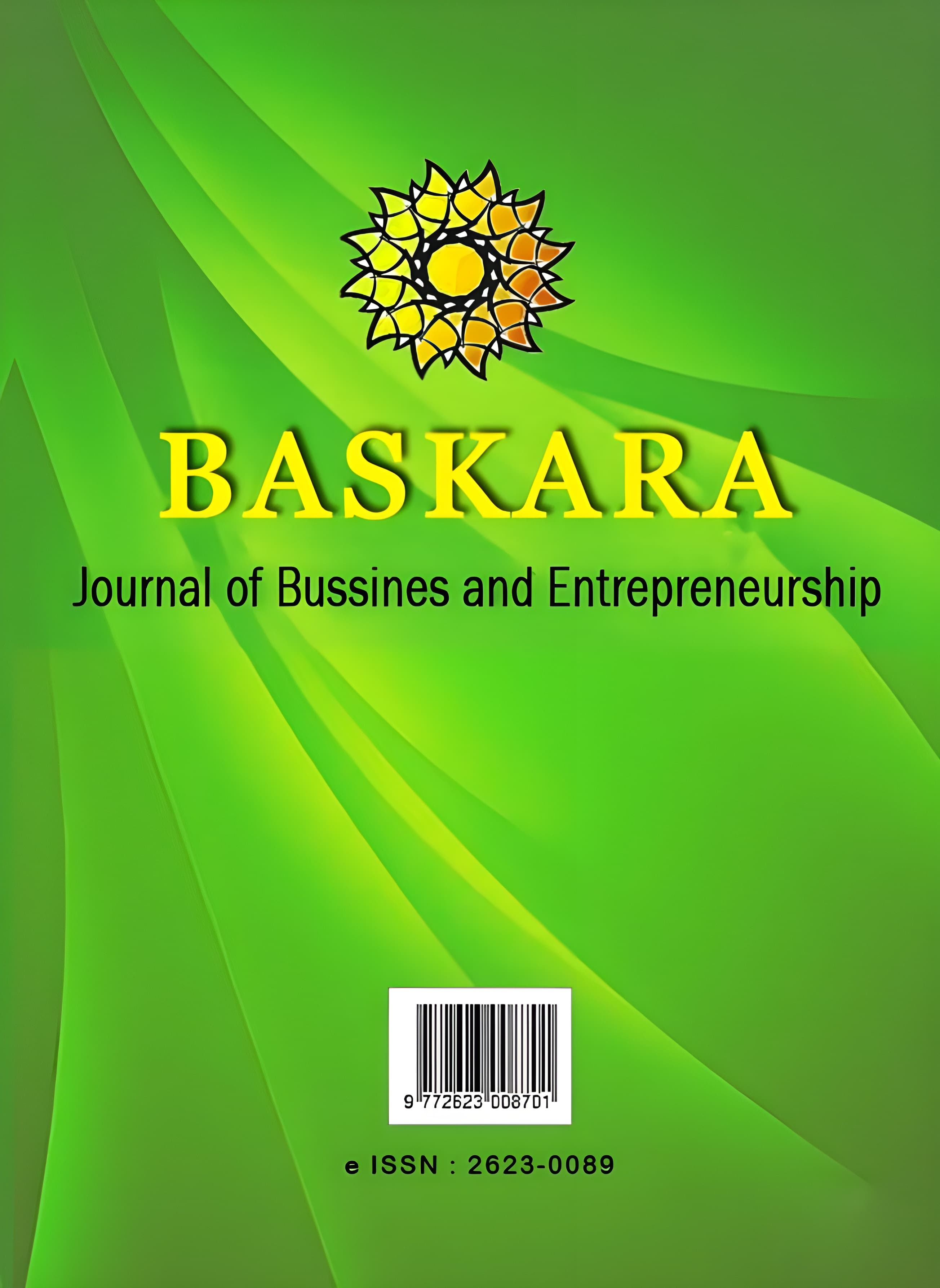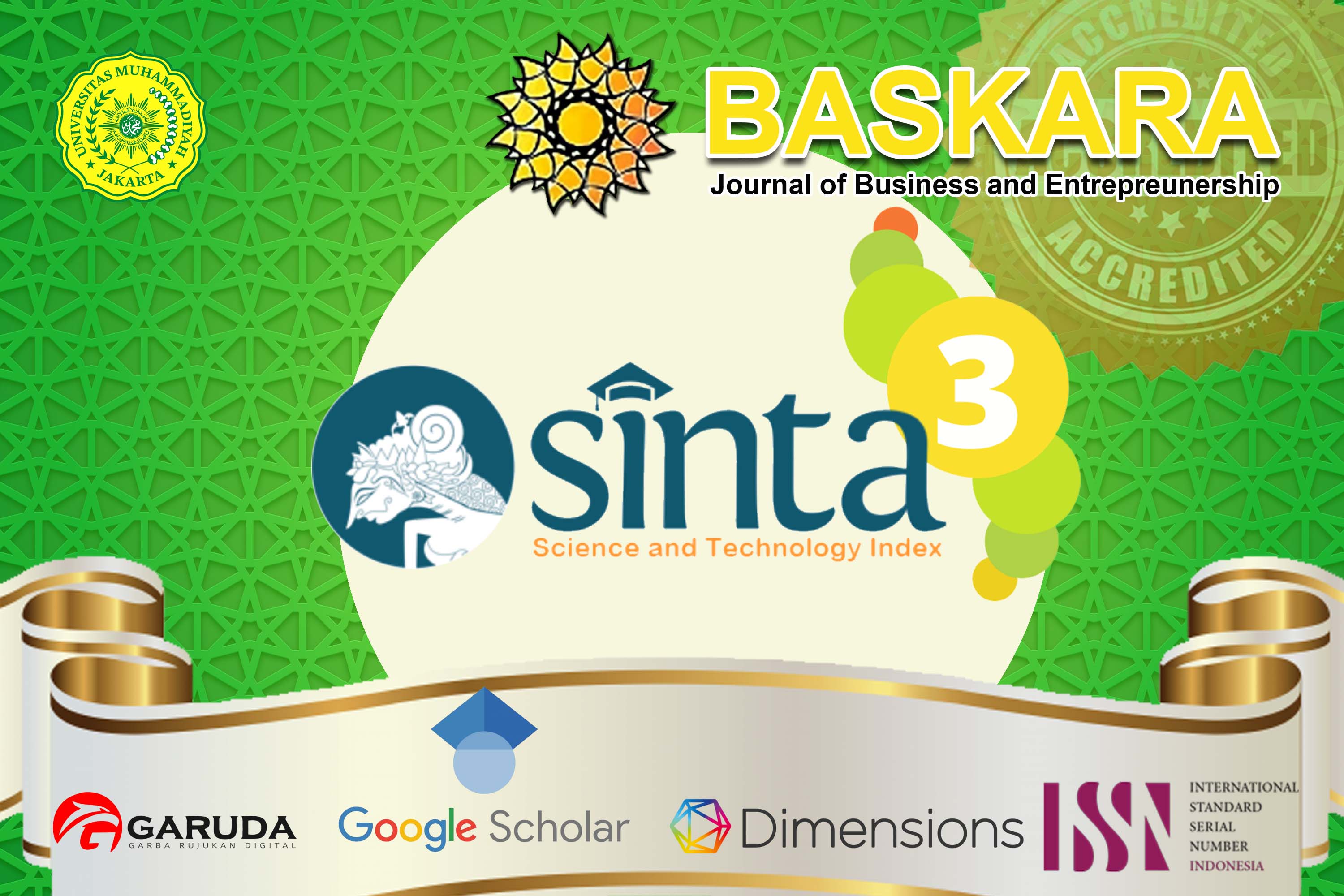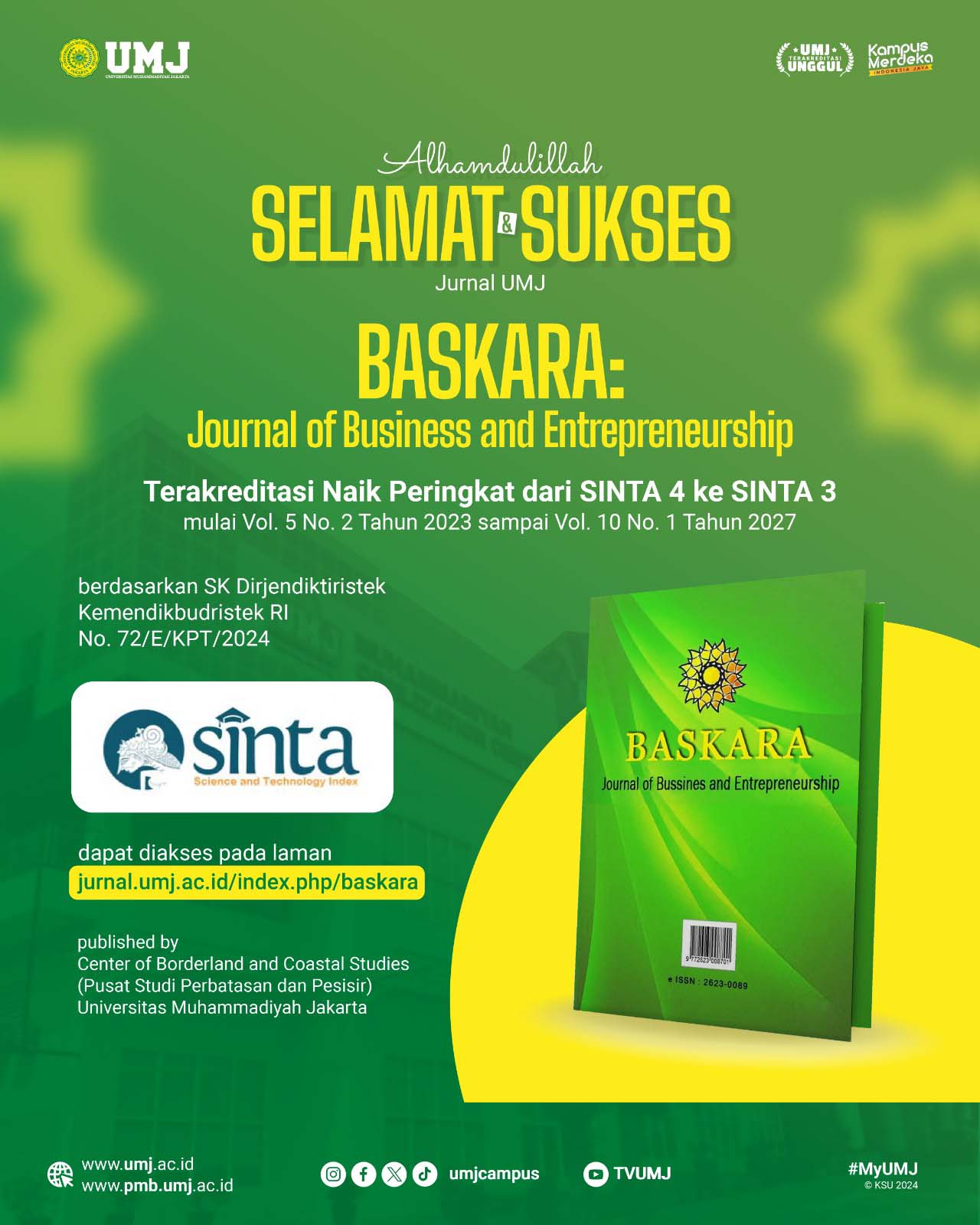The Influence of Marketing on Instagram and Ewom Social Media on Purchase Decisions is Mediated by Brand Trust at Fore Coffee Ngagel Surabaya
Keywords:
Instagram, EWOM, Purchasing decisions, Brand image, and Brand trustAbstract
This study aims to analyze the impact of marketing through social media, Instagram, and Electronic Word of Mouth (EWOM) on purchasing decisions, considering the mediating roles of Brand image and Brand trust at the Fore Coffee branch in Ngagel, Surabaya. The method used in this research is quantitative with a survey approach, where the questionnaire is the primary data collection tool. The obtained data were analyzed using the Structural Equation Model (SEM) with the assistance of WarpPLS 7.0 software. The results indicate that Instagram and EWOM positively and significantly influence purchasing decisions directly and indirectly through Brand image and Brand trust. Instagram contributes 27.6% to purchasing decisions, while EWOM contributes 14.8%. Additionally, Brand image and Brand trust act as mediators in the influence of Instagram and EWOM on purchasing decisions, with contributions of 22% and 23.1%, respectively. This research provides practical implications for Fore Coffee in optimizing marketing strategies through Instagram and enhancing service quality to maintain customer satisfaction.References
Adriana, D. (2017). Strategi Bersaing dalam Industri Kopi. Jurnal Manajemen Bisnis, 12(3), 45-56.
Anizir, A., & Wahyuni, S. (2017). Pengaruh Media Sosial terhadap Brand Image dan Keputusan Pembelian. Jurnal Pemasaran, 8(2), 123-134.
Armawan, A. (2023). Peran Electronic Word of Mouth (EWOM) dalam Pemasaran Digital. Jurnal Ilmu Komunikasi, 15(1), 67-78.
Badan Pusat Statistik. (2023). Produksi Kopi di Indonesia.
Bernardo, F., et al. (2020). The Impact of Social Media on Brand Trust. Journal of Marketing Research, 55(4), 789-801.
Boyd, D. M., & Ellison, N. B. (2007). Social Network Sites: Definition, History, and Scholarship. Journal of Computer-Mediated Communication, 13(1), 210-230.
Djakasaputra, A. (2021). Metode Penelitian Kuantitatif. Jakarta: Penerbit Erlangga.
Ervina, E. , dan Kurniawati, M. (2022). Pengaruh Citra Merek Dan Kepercayaan Merek Terhadap Loyalitas Merek Peralatan Kebersihan Rumah Tangga Merek X. Prosiding Serina, 2(1), 703-708.
Ferdinand, A. (2014). Metode Penelitian Manajemen. Semarang: Badan Penerbit Universitas Diponegoro.
Firmansyah, M. A. (2019) Pemasaran: Produk Dan Merek (Planning Dan Strategy). Surabaya: Qiara Media.
Goyette, I. , L. Richard, J. Bergeron, and F. Marticote. 2012. EWOM Scale: Word of Mouth Measurement Scale for E-Service Context. Canadian Journal of Administrative Sciences, Vol. 27, No. 1, pp. 5-23.
Gumulya, D., & Helmi, A. (2017). Tren Coffee Shop di Kota Metropolitan. Jurnal Sosial dan Budaya, 9(2), 89-100.
Hair, J. F., et al. (2021). Multivariate Data Analysis. Pearson Education Limited.
Hendrayanti, S. , dan Terini, U. (2021). The Impact Of Brand Image, Brand Trust And Brand Awareness On Aqua Loyalty Brand. JURNAL CAPITAL: Kebijakan Ekonomi, Manajemen dan Akuntansi, 3(2), 116-133.
Ibrahim, M., et al. (2021). The Role of Instagram in Brand Awareness. Journal of Digital Marketing, 12(3), 45-58.
Irawan, E. , dan Yusuf, Y. (2017). Instagram sebagai Gaya Hidup Masyarakat Kota Pekanbaru (Studi Komunitas Instagram di Kota Pekanbaru) (Doctoral dissertation, Riau University).
Ismagilova, E. , Dwivedi, Y. K. , . . . dan Williams, M. D. (2017). Electronic word-of-mouth (eWOM) (pp. 17-30). Springer International Publishing.
Jalilvand, M. R. (2012). The Effect of Electronic Word of Mouth on Brand Image and Purchase Intention. Journal of Marketing Communications, 18(2), 123-145.
Jansen, B. J., et al. (2009). Twitter Power: Tweets as Electronic Word of Mouth. Journal of the American Society for Information Science and Technology, 60(11), 2169-2188.
Kaplan, A. M., & Haenlein, M. (2010). Users of the World, Unite! The Challenges and Opportunities of Social Media. Business Horizons, 53(1), 59-68.
Kotler, P., & Armstrong, G. (2016). Principles of Marketing. Pearson Education Limited.
Kotler, Philip and Keller Kevin Lane. 2009. Principles of Marketing. 13th Edition. Prentice Hall. New Jersey.
M Nisrina. (2015). Bisnis Online : Manfaat Media Sosial dalam Meraup Uang. Yogyakarta: Komunitas Bisnis
Mamahit, C., et al. (2015). The Impact of Brand Trust on Consumer Loyalty. Journal of Consumer Behaviour, 14(3), 123-135.
Martono, N. (2015). Metode Penelitian Kuantitatif. Jakarta: Rajawali Press.
Nurhidayati, S. (2022). Pengaruh Instagram terhadap Keputusan Pembelian. Jurnal Manajemen Pemasaran, 10(1), 34-45.
Prabandari, L., et al. (2018). The Role of EWOM in Building Brand Image. Journal of Marketing Management, 34(5), 567-580.
Purwanto, A., et al. (2021). Structural Equation Modeling dengan WarpPLS. Yogyakarta: Penerbit Andi.
Ridho, M. (2013). E-Marketing dan Brand Image. Jurnal Manajemen dan Bisnis, 7(2), 89-100.
Sanny, L., et al. (2020). The Impact of Social Media Marketing on Brand Trust. Journal of Digital Marketing, 11(4), 56-68.
Sari, R., Saputra, A., & Husein, Y. (2017). Pengaruh EWOM terhadap Keputusan Pembelian. Jurnal Ilmu Manajemen, 9(3), 123-134.
Sugiyono. (2019). Metode Penelitian Kuantitatif, Kualitatif, dan R&D. Bandung: Alfabeta.
Tjiptono, F. (2012). Strategi Pemasaran, (3rd ed.). Yogyakarta: Andi
Wahyuni, S. (2022). Instagram sebagai Media Promosi Efektif. Jurnal Komunikasi dan Media, 14(2), 67-78.
Wijaya, T. (2021). Kontribusi Kopi terhadap Perekonomian Indonesia. Jurnal Ekonomi dan Bisnis, 13(1), 45-56.
Yuliawan, D. (2021). Analisis Data dengan SEM. Jakarta: Penerbit Erlangga.
Downloads
Published
Issue
Section
License
Copyright (c) 2025 BASKARA : Journal of Business and Entrepreneurship

This work is licensed under a Creative Commons Attribution-NonCommercial 4.0 International License.
In order for Baskara: Journal of Business and Entrepreneurship to publish and disseminate research articles, we need publishing rights (transfered from author(s) to publisher). This is determined by a publishing agreement between the Author(s) and Baskara Journal. This agreement deals with the transfer or license of the copyright of publishing to Baskara: Journal of Business and Entrepreneurship, while Authors still retain significant rights to use and share their own published articles. Baskara : Journal of Business and Entrepreneurship supports the need for authors to share, disseminate and maximize the impact of their research and these rights, in any databases.
As a journal Author, you have rights for a large range of uses of your article, including use by your employing institute or company. These Author rights can be exercised without the need to obtain specific permission. Authors publishing in Baskara : Journal of Business and Entrepreneurship have wide rights to use their works for teaching and scholarly purposes without needing to seek permission, including:
- use for classroom teaching by Author or Author's institution and presentation at a meeting or conference and distributing copies to attendees;
- use for internal training by author's company;
- distribution to colleagues for their reseearch use;
- use in a subsequent compilation of the author's works;
- inclusion in a thesis or dissertation;
- reuse of portions or extracts from the article in other works (with full acknowledgement of final article);
- preparation of derivative works (other than commercial purposes) (with full acknowledgement of final article);
- voluntary posting on open web sites operated by author or author’s institution for scholarly purposes.
Copyright Transfer Agreement for Publishing (Publishing Right)
The Authors who submit manuscript has to understand that if accepted for publication, mean that all copyright and publishing right of the article shall be assigned/transferred to Baskara: Journal of Business and Entrepreneurship as assigned publisher.
- CC BY-NC: This license allows reusers to distribute, remix, adapt, and build upon the material in any medium or format for noncommercial purposes only, and only so long as attribution is given to the creator.
It includes the following elements:
BY ![]() – Credit must be given to the creator
– Credit must be given to the creator
NC ![]() – Only noncommercial uses of the work are permitted
– Only noncommercial uses of the work are permitted
Baskara (C) Copyright (2022):
BASKARA: Journal of Business and Entrepreneurship by https://jurnal.umj.ac.id/index.php/baskara
is licensed under a Creative Commons Attribution-NonCommercial 4.0 International License








